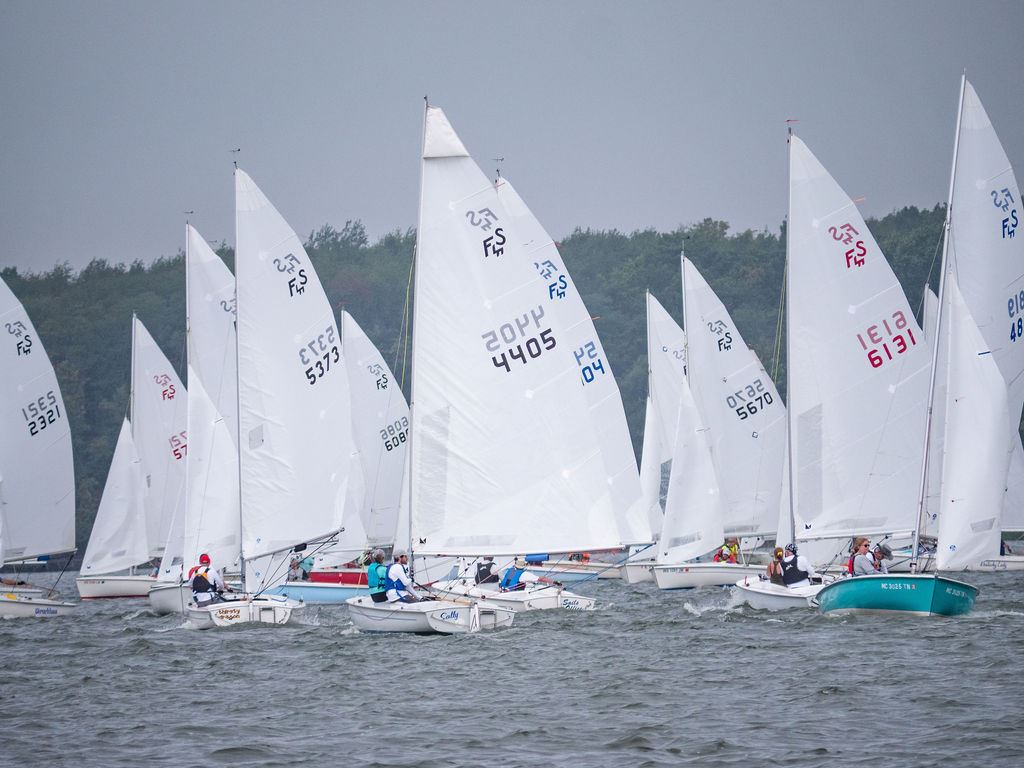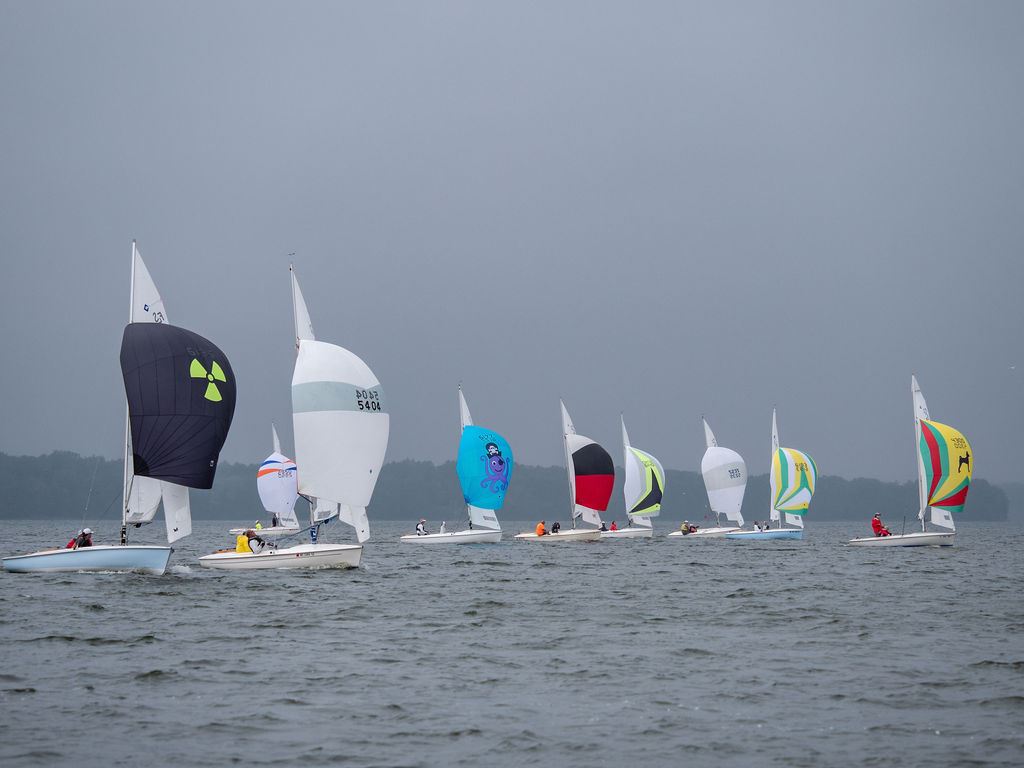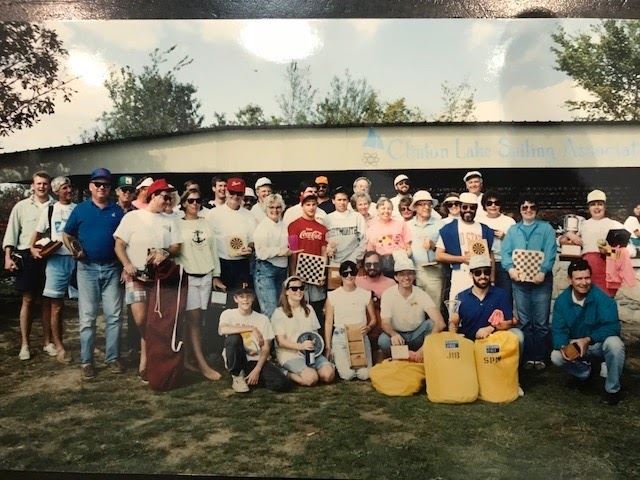|
Racers can Learn to Sail for Free at CLSA
Flying Scot Sailing is about having fun and getting better. We are recreational racers who enjoy great one-design sailing and exceptional fellowship. Fleet 135 hosts the Glow in the Dark Regatta (Sep 14-15). If you are interested in crewing in the Glow or eventually skippering one of our loaner boats in the Glow, our instructors and coaches will teach you how to sail and coach you every step of the way. Fleet 135 works in partnership with other Midwest District fleets and our traveling racers support other district regattas. We host Beer Can Races every Wednesday at CLSA. Many of our fleet members participate in Saturday coaching clinics and Beer Can Races with Fleet 215 on Lake Decatur. If you are interested in racing with us at the Glow, click here to learn more and sign up to Crew at our Beer Can Races. Fleet Captain Dan will follow up and give you a free introductory lesson, give you access to free online education tools at SailboatInstructor.com, and help get you get on a sailboat at an upcoming Beer Can Race. If you just want to try sailing on a Flying Scot, attend one of our Free Sailboat Ride events or consider signing up for an Introductory Lesson ($25).
Please contact Dan Leach at fleet135captain@gmail.com if you have any questions about Flying Scot sailing at CLSA or beyond.
GLOW IN THE DARK REGATTA September 14-15 Click here to access the 2024 Regatta Network event page to sign up, see who is coming, and more. Questions? Contact Fleet Captiain Dan Leach at fleet135captain@gmail.com | Glow in the Dark Regatta “The Glow” is hosted by the Clinton Lake Sailing Association and Fleet 135 and takes place on the first weekend of October. 39 Flying Scots raced in 2023. The event was originally named the Glow in the Dark Regatta because Clinton Lake is a cooling lake for the nuclear plant. The first version of the event was held between 1985-1999. Those who were around during the 80s and 90s tell us the party was legendary. Deb Aronson and Ben Williams reintroduced the Glow II Regatta in 2007 and it has grown into one of the largest and most popular events on the FSSA regatta calendar. Those who travel to Clinton Lake are treated like family and can look forward to exceptional racing, food, and fun. Please click here to read Eric's 2021 Scots 'n Water article and click here to read Eric's 2022 article published in the Flying Scot Sailing Sailing Association class magazine. |
|
Glow Regatta Results
| .jpg) |
If you're still reading and curious about the history of The Glow in the Dark Regatta, here you go! You'll be happy to read that many of the traditions are still going to this day! The Hartmans: Focus on Fun The triumvirate of G.W. (Gerry), Steve and Mike Hartman, at least among some Flying Scot sailors, is legendary. The Hartmans — G.W. is cousin to brothers Mike and the late Steve Hartman — began buying Flying Scots in 1973 six years before their home lake, Clinton Lake Sailing Association (CLSA), ever existed. Clinton Lake was created in 1979 as the cooling pond for the Clinton nuclear power plant. Prior to that, the Hartmans raced Banshees, a single-handed boat, at tiny Homer Lake near Urbana-Champaign. The lake was barely large enough for a start line. In anticipation of the building of Clinton Lake the Hartmans bought Flying Scots. They tried to sail them on Homer Lake for a while, but the sailors of the smaller boats suggested they go elsewhere. With no lake, but a desire to sail, the three Hartmans began to travel. They often took the trip to Carlyle Lake, Crab Orchard and Lake Michigan. Gerry first attended Midwinters in Panama City in 1978 or ‘79 and Mike and Steve joined him in 1980. That event became a fixture on the fleet calendar. Jerry would attend every year until the event moved away from Panama City. His motorhome, aka “the Hilton” became a fixture with its assigned parking spot and was the center of social gatherings for the duration. Their stories of Midwinters brought other fleet 135 members into the event. Once Clinton Lake filled, the Hartmans were instrumental in building up the Clinton Lake Sailing Association facilities once the lake filled. Gerry and long-time crew Ken Johnson built the CLSA pavilion using some “left over” materials from a recent construction project (with a much younger John Domagala sheeting the roof). Mike and fleet member Bob Clay built the grill that stands to this day. The Hartmans got the idea for the annual Glow in the Dark regatta, which they held from 1985-1999), after they stepped up to host the 1984 Midwest Districts. That event was scheduled for Minnesota, but the venue fell through at the last minute. The Hartmans, never having hosted a regatta but having attended many, volunteered to host the event at Clinton Lake. That first, successful event led the Hartmans to host the “Glow in the Dark Regatta” the following year. Having lost “buckets of money” and having to deal with the headache of bounced checks and bookkeeping at the District event, the Hartmans determined that “the money was more trouble to keep track of than it was worth,” according to Mike. Consequently, when they decided to host the Glow, it was completely free. “We figured people incurred the cost of traveling and gas and hotels sometimes, so we wanted to make the entry free,” says Sunshine. Steve, who died in 2011, was an ardent amateur chef. “Steve loved to cook for a lot of people in difficult circumstances,” Mike said. In the CLSA archives is a list of foods Steve prepared for the event. They are mostly things you can freeze and then thaw slowly, since CLSA has no electricity or water. The list includes ribs, pork roast, gyros, rice salad, spaghetti marinara and spaghetti aoli-oglio, as well as “flambe du fruit.” All weekend a ten-foot-long dinghy was filled with ice to hold mixers for drinks and also orange juice and milk, etc for breakfasts. with orange juice, milk and more. GW and Sunshine bought the trophies, Steve bought all the food, and Mike bought all the drinks. “We enjoyed so many regattas at other fleets’ lakes,” says Mike, “we felt we owed a lot of good times to the others.” “The donations started when people asked ‘what do I owe?’” says John Domagala. “The answer was, ‘if you feel compelled to help out bring something from your area.’ The Wisconsin folks led the regatta in brats, the Texas folks kept us in chili, Carlyle always fed us Sunday breakfast, and Cincinnati and others kept us in beers.” Some high points include 1989, when Sunshine and GW got married the Friday before the Glow. Although they had a reception at their house, the wedding party and feast continued into the weekend at the lake. The Glow attracted about 40-45 boats on average, but that year 64 boats came. Sailors from Boston brought 200 Maine lobsters, and Doc Bellows ad Jane Campion brought 100 pounds of shrimp from the Gulf. This was on top of the meals that Steve had planned to create. In 1994, John and Susie Domagala had a pre-wedding bash at the Glow and many people got dressed up for the Saturday party in wedding garb. That gave Sunshine the idea the following year to have a costume party. “People got so into it, I didn’t even recognize them,” she said. They had a few people serve as judges and they wore judge robes. Peg and John Woodward came dressed as Sunshine and GW, complete with custom-made masks. Sunshine was checking people in. “I looked up and there I was, it was crazy!” she said. GW and Sunshine also were in charge of race committee. The goal, always, was to have fun, so they modified the typical regatta format. They wanted as many people as possible to trophy. “For many of them it was the first trophy they’d ever won,” says Sunshine. They created four divisions and racers competed in a round robin model. The top sailors — the professionals and those who typically trophied — no matter the division, were skimmed off into their own championship division for trophies and then the remaining sailors in each division also got trophies. So if you were in a division with Harry Carpenter and Greg Fisher, and you finished third, you would win your division because they would have been scored in the championship division. The trophies, which Sunshine and GW were in charge of, were useful. “We didn’t want to give out ‘pickle dishes,’” says Sunshine. So all through the year they’d collect things: dartboards, magazine racks, napkin holders and they’d put a plate on them with the details of the event. People would use them in their daily lives and it would serve as a fun reminder. There were also a few perpetual trophies, like the toilet seat, which went to the person who “won the party,” the hammock which went to the winner of the white division, and the multi-colored sail made by Doc Bellows of Schurr Sails that the winner of the blue division had to use the following year. Sailors were expected to settle disputes on the water. Protests were allowed in that you could protest someone on the water, but if you wanted to file a protest, GW decreed it would cost $250 and the hearing would be held at 2 a.m. On the other hand, if someone was really causing trouble, either by fouling people on the water and not doing turns or complaining about the event and generally being unpleasant, they would not be invited back. Sunshine remembers one person who complained vociferously about the race committee. The three Hartmans had a meeting, then walked over and told that sailor he was not invited back. But that was, of course, the exception to the rule. Generally speaking, if you find yourself in a room of Flying Scot sailors of a certain age and you ask them about the Glow, they’ll share countless stories of the craziness and fun that ensued. |
 Clinton Lake Sailing Association
Clinton Lake Sailing Association

